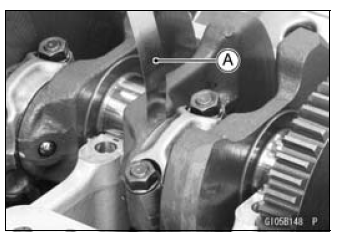

Insert a thickness gauge [A] between the big end and either crank web to determine clearance.
Connecting Rod Big End Side Clearance
Standard: 0.13  0.38 mm
0.38 mm
(0.0051  0.0150 in.)
0.0150 in.)
Service Limit: 0.58 mm (0.023 in.)

If the clearance exceeds the service limit, replace the connecting rod with new one and then check clearance again.
If the clearance is too large after connecting rod replacement, the crankshaft also must be replaced.
 Connecting Rod Twist Inspection
Connecting Rod Twist Inspection Connecting Rod Big End
Bearing Insert/Crankpin Wear Inspection
Connecting Rod Big End
Bearing Insert/Crankpin Wear InspectionSidestand Installation
Replace the sidestand nut [A] with a new one.
Apply grease to the sliding areas [B].
Tighten the sidestand bolt [C] first, and then the sidestand
nut.
Torque - Sidestand Bolt: 44 N·m (4.5 kgf·m, 32 ft·lb)
Sidestand Nut: 29 N·m (3.0 kgf·m, 21 ft·lb)
Install the spring [D] as sh ...
Nozzle Assy Disassembly
Remove the nozzle assy (see Nozzle Assy Removal).
Pull out the secondary fuel injectors [A] from the delivery
pipe assy [B].
NOTE
Do not damage the insertion portions of the injectors
when they are pulled out from the delivery pipe assy.
NOTICE
Never drop the secondary fuel injecto ...
Drive Chain Wear Inspection
Remove the chain cover (see Drive Chain Removal/Installation
in the Final Drive chapter).
Rotate the rear wheel to inspect the drive chain for damaged
rollers, and loose pins and links
If there is any irregularity, replace the drive chain.
Lubricate the drive chain if it appears dry.
...